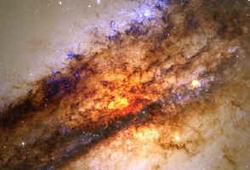Black Holes with No Strings Attached
One of the great challenges in physics is to develop a theory of gravity that obeys the rules of quantum mechanics. String theory, which describes all matter in terms of tiny stringlike objects and multidimensional membranes, may ultimately solve the problem. String theory proponents have had a series of triumphs recently as they’ve calculated black hole properties, including their ability to radiate, in agreement with nonstring calculations. But a report in the 21 September PRL suggests that those results can also come from a much simpler theory–one that treats the black hole radiation problem like the textbook system of atoms emitting photons.
In the early 1970s Stephen Hawking showed that a black hole must emit radiation from just outside its event horizon, the surface beyond which nothing escapes its overwhelming gravity. Although general relativity, the successful classical theory of gravity, says nothing about the phenomenon, Hawking showed that quantum mechanics predicts the radiation. The virtual particle pairs that continuously materialize and then immediately recombine everywhere else in space cannot recombine when they form at a black hole horizon, which leads to the emission of particles.
In the past three years string theory has come a step closer to acceptance because string theorists have reproduced Hawking’s results, including black hole radiation, by methods completely different from his. But Roberto Emparan and Ivo Sachs, of the University of Durham in the United Kingdom, wanted to see whether the full complexity of string theory was required for those results. They recalled that Hawking treated the black hole as fixed and classical but used quantum theory to describe the radiation. Emparan and Sachs chose to reverse that view, considering the black hole as analogous to an atom having many quantum states and capable of making transitions among them as it emits or absorbs radiation. Their method was similar to the textbook description of such an atom interacting with light, where the light is treated as a classical, weakly interacting background field. The real world has three dimensions in space and one in time, but they avoided mathematical complications by working in an imaginary world with one less spatial dimension.
The team was able to reproduce Hawking’s formula for black hole radiation, a feat Emparan says may “help elevate other alternative approaches to a status closer to that recently reached by string theory.” Although Emparan admits this simple theory may eventually run into trouble, he expects to learn about quantum gravity by continuing to study black holes in this way. “We want to see how far we can go without using string theory,” he says.
Steven Carlip of the University of California at Davis says that, assuming the results hold up under further scrutiny, the authors have shown that “some of the string theory results didn’t really need string theory.” But he notes that some string theorists suspect the derivation may be mathematically equivalent to the string theory work. “The question is whether there’s hidden string theory in there,” says Carlip, but he believes the new work is probably string independent.
More Information
Related papers from PRL–applications of string theory to black holes: Phys. Rev. Lett. 77, 2368 (1996).



